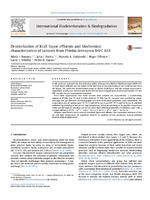Decolorization of Kraft liquor effluents and biochemical characterization of laccases from Phlebia brevispora BAFC 633
Date
2015-10-01Author
Fonseca, María Isabel
Fariña, Julia Ines
Sadañoski, Marcela Alejandra
D'Errico, Roger
Villalba, Laura Lidia
Zapata, Pedro Darío
Metadata
Show full item recordAbstract
In this work we evaluated the decolorization ability of fungus identified as Phlebia brevispora BAFC 633 on Kraft liquor effluents and we looked at the biochemical characterization of two novel laccases from the fungus. We conducted decolorization assays on diluted Kraft liquor with the enzyme supernatants. Ligninolytic activity was demonstrated by the 20% reduction of lignin peak absorbances between 215 and 280 nm after laccase supernatants treatment.
From these supernatants, two novel laccases were isolated and characterized: a constitutively expressed 60-kDa (Lac A), and a CuSO4-induced 75 kDa (Lac B). Laccases were purified by anion-exchange and gel filltration chromatography and their biochemical properties were determined. The temperature and pH optima were 70–75 °C and 4.8 for Lac A, and 60–70 °C and 4.4 for Lac B; and both exhibited high stability at low pH and high temperature. Substrate specificity of the purified enzyme was tested and the highest oxidation was to 2,2′-azino-bis(3-ethylbenzothiazoline-6-sulphonic acid) with a catalytic efficiency of 2.6 × 107 s−1 mol l−1 for Lac A and 9 × 108 s−1 mol l−1 for Lac B.
Enzyme supernatants can be used to remediate lignin-rich effluent. The isoenzymes tolerance to low pH and high temperature are significant features to optimize laccase production toward potential biotechnological applications.
Collections
The following license files are associated with this item:




